


Shigatse

September 1 – Shalu temple and Shigatse
M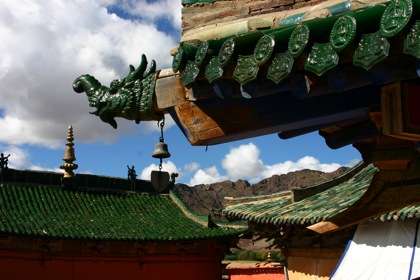 any more monasteries today!
any more monasteries today!
 any more monasteries today!
any more monasteries today!After a short drive from Gyantse, we reach the Shalu monastery, which is a Tibetan/ Chinese hybrid: The roofs are the same green tiles as in the forbidden city. Otherwise there was not much action, and the special training (“flying monks”) remained elusive.
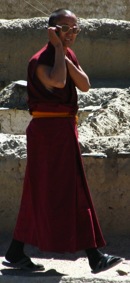
On the way to Shigatse, we visited Shalu temple, architecturally an interesting cross between the “standard” Buddhist monastery and the forbidden city (green ceramic tiled roofs tilted upwards, dragons on the corners of the roof, etc.). The atmosphere was leisurely, and even though Dawa rambled on quite a bit about the college of medicine and Tibetan healing methods, the famous “flying monks” remained hidden. We spotted one monk tanning on the rooftop, though, wearing sunglasses and chatting on his cellphone! We’re all humans, after all.
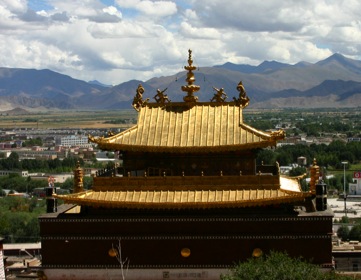 More interesting was the monastery of Shigatse, the fifth of the “big six” that we visited. This monastery likes things big: Not only is it big itself, it has a giant building with one item – a 28 m Buddha. The next building: A giant stupa that serves as a tomb for the tenth Panchen Lama. And so forth. We attended a tantric service that was very interesting, with the Tibetan horns and cymbals accompanying the guttural singing. Moreover, in the room was a freshly completed sand mandala. This incredibly complicated work of art only has a short lifetime. After being on display for a couple of says, it is destroyed. Rumor had it (courtesy of Dawa) that it had been made for the Panchen Lama (the fake Chinese one) who was going to visit in three days.
More interesting was the monastery of Shigatse, the fifth of the “big six” that we visited. This monastery likes things big: Not only is it big itself, it has a giant building with one item – a 28 m Buddha. The next building: A giant stupa that serves as a tomb for the tenth Panchen Lama. And so forth. We attended a tantric service that was very interesting, with the Tibetan horns and cymbals accompanying the guttural singing. Moreover, in the room was a freshly completed sand mandala. This incredibly complicated work of art only has a short lifetime. After being on display for a couple of says, it is destroyed. Rumor had it (courtesy of Dawa) that it had been made for the Panchen Lama (the fake Chinese one) who was going to visit in three days. 
After the tantric service we looked at another service in a larger hall, attended by many very young monks in yellow robes, who almost couldn’t keep themselves from mischief.
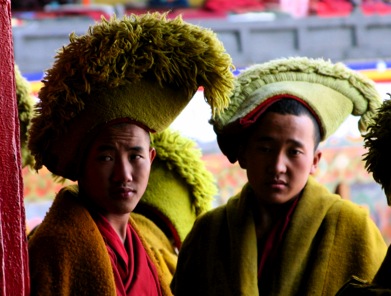

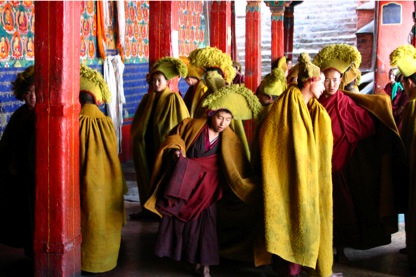 We then visited Tashilumpo monastery, home to the Panchen Lama (or one of them – currently there exist a Tibetan and a Chinese-approved reincarnation, both young boys and pawns, it seems, in the China-Tibet struggle). Here we witnessed an interesting ceremony – a prayer of the younger students in the main assembly hall. (The seat of the Panchen Lama remained ominously empty). The monks met in front of the prayer hall, all donning yellow robes and hats (as a sign of their belonging to the Gelupka or “yellow cap” order). Suddenly, one young boy begin to sing rather enthusiastically, the others joined in, and, on a cue I didn’t detect, the monks STORMED into the hall, where they had a rather disorderly praying (or, in the case of the very young, crawing) session, some cradling sprite bottles filled with yak butter tea in their laps. The service ended as abruptly as it has started, with the monks running out of the prayer hall as if on cue.
We then visited Tashilumpo monastery, home to the Panchen Lama (or one of them – currently there exist a Tibetan and a Chinese-approved reincarnation, both young boys and pawns, it seems, in the China-Tibet struggle). Here we witnessed an interesting ceremony – a prayer of the younger students in the main assembly hall. (The seat of the Panchen Lama remained ominously empty). The monks met in front of the prayer hall, all donning yellow robes and hats (as a sign of their belonging to the Gelupka or “yellow cap” order). Suddenly, one young boy begin to sing rather enthusiastically, the others joined in, and, on a cue I didn’t detect, the monks STORMED into the hall, where they had a rather disorderly praying (or, in the case of the very young, crawing) session, some cradling sprite bottles filled with yak butter tea in their laps. The service ended as abruptly as it has started, with the monks running out of the prayer hall as if on cue. 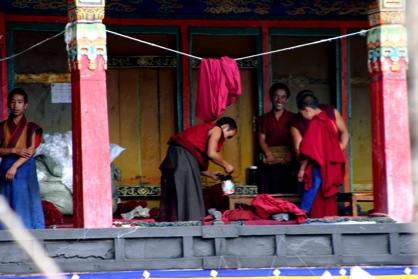 Also at Tashilumpo, we saw a completed sand mandala, protected by a round “cage” made of wire netting. A spectacularly intricate affair we started at for a very long time, the mandala made us curious as to how long it would take to create one – and whether monks are allowed to us a mini-vacuum-cleaner if they make mistakes! Later on, a tantric prayer took place in the mandala room – a cryptic ritual with ringing bells and cymbals, very beautiful. I happened to catch some sun outside when the monks arrived for the prayer, each of them hectically untying their shoe laces (no sandals in Tashilumpo, but maroon boots that looked very traditional). One of them was late and, as he unknotted the shoelaces, he looked up and whispered to me, “hello – tashi delek…” and sprinted up the stairs.
Also at Tashilumpo, we saw a completed sand mandala, protected by a round “cage” made of wire netting. A spectacularly intricate affair we started at for a very long time, the mandala made us curious as to how long it would take to create one – and whether monks are allowed to us a mini-vacuum-cleaner if they make mistakes! Later on, a tantric prayer took place in the mandala room – a cryptic ritual with ringing bells and cymbals, very beautiful. I happened to catch some sun outside when the monks arrived for the prayer, each of them hectically untying their shoe laces (no sandals in Tashilumpo, but maroon boots that looked very traditional). One of them was late and, as he unknotted the shoelaces, he looked up and whispered to me, “hello – tashi delek…” and sprinted up the stairs.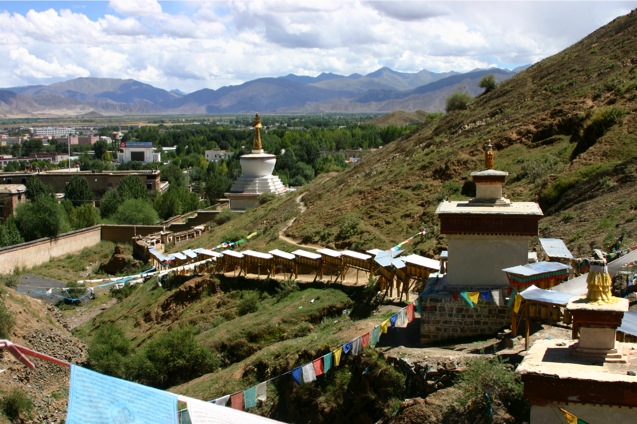
Part of the Kora around Tashilumpo


